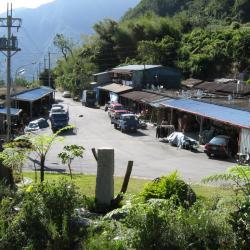Xibao is located 161 kilometers away from the Zhongheng Highway. It is a large river terrace. Anthropologists have discovered pottery and stone spinning wheels on the Xibao terrace, which may have been left by humans in the late Neolithic period. About 250 to 300 years ago, after the Truku people settled in the Liwu River valley, they established the Xibao community here. After the Japanese implemented the Lifan policy in 1915, they were forced to move away. After World War II, some returned to the tribe. When the Zhongheng highway began to be excavated, vegetables and fruits were grown on the terraces of Xibao River due to the inconvenient transportation of vegetables in mountainous areas, and Xibao Farm was established. After the highway was opened, the Retirement Association arranged for the veterans to settle here. There is Xibao Elementary School on the terrace. It was originally a school for the children of the Xibao Farm workers, and later it was changed to Forest Primary School. It is the only forest primary school in the country and the only primary school inside the national park.
